
Jordan, home of the Lost City of Petra, and land of starry desert nights. This country is small, but if it’s an adventure you’re after, it will deliver. Independent travel is the best way to see the country on your own terms, and even without a car, it’s possible to see the highlights in one action packed week. Here is the ultimate travel guide and itinerary for 1 week in Jordan for solo female travelers.
Introduction

Jordan is a new country, on land with history that dates back further than biblical times. This region has played a prominent role in religious history, with many references to this ancient land in religious literature. It was on Mount Nebo that Moses was said to gaze at the Promised Land. According to the bible, Jesus was baptized on the Jordanian banks of the Jordan River. Today, it is one of the most stable and peaceful countries in the region, currently ruled under a monarchy.
It’s a small country, so you can see a lot in just 1 week in Jordan.
Things to Know Before you Go
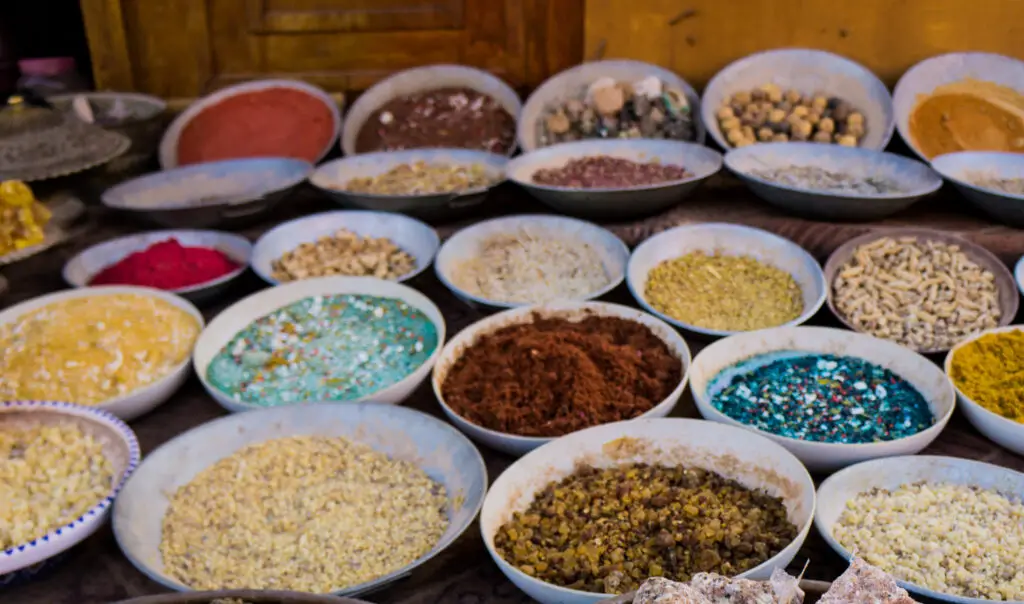
Check the Visa Requirement
Almost all foreign nationals will need a visa to enter Jordan With the exception of a few, which are those from Bahrain, Egypt, Israel, Kuwait, Lebanon, Oman, Palestinian Authority, Qatar, Saudi Arabia, Turkey, Tunisia, or the United Arab Emirates.
For Americans, we can obtain a visa on arrival. It will cost 40 dinars, but I strongly recommend getting the Jordan Pass instead.
Get the Jordan Pass
As long a your trip is longer than 3 days, you probably should get the Jordan Pass. The fee includes your entry into the country, so you won’t need to purchase a visa, additionally, saving you $56 USD.
The Jordan Pass will give you free entry into 40 of the countries historic and tourist sites. Entry into Petra alone costs 55 Dinars ($78 USD), so the pass pays for itself by covering that and the cost of a visa.
I recommend the Jordan Explorer Pass, which is 75 dinars ($106 USD) because it allows you to visit Petra for two days, which is necessary if you want to see it all.
Plus, it will save you money on any other paid tourist activities included on the pass.
What to Pack
Jordan is a desert, so while scorching temperatures may come to mind, if you are visiting in the winter months, it will be cold.
I visited Jordan in February, and while the day time temperatures were still t-shirt weather, the nights were freezing. Make sure to pack according to the season.
Additionally, Jordan is a muslim country and the local dress code should apply here. Although my airbnb host assured me that they are becoming increasingly easy-going towards these rules, it’s better to err on the side of caution to avoid unwanted attention.
1 Week in Jordan Packing List
- 3-4 T-shirts: To be worn in warm months alone and to be layered in colder months. In all seasons, it’s pretty hot at Petra during the day, so loose, breathable fabrics are best.
- 1-2 Maxi skirts: More comfy and breathable than pants, and are culturally appropriate
- 1 Pair of sandals: For exploring in the cities in summer, and necessary when visiting the Dead Sea.
- Hiking shoes: I managed without a pair, but you’ll do better if you bring them. Outside the cities, you’ll often walk on rocky, uneven terrain or sand. Bring sturdy shoes that are comfy to walk in all day.
- 1 hiking outfit: You’ll do some hiking at Petra and when walking to Wadi Mujib. Bring some leggings or yoga pants and a hiking top that covers both the shoulders and your belly
- 1 bikini: to be worn at the sea
- 1-2 maxi dresses (optional): These are comfortable, culturally appropriate, and look beautiful in photos
- A hat: The sun here is strong and you’ll be glad you brought one
- Sunglasses: Necessary at the sea and in the desert
- A Scarf: For entering mosques
- Enough clothes to sleep in: Keep in mind, when you visit Wadi Rum it is likely you will camp. Bring something you’d be comfortable and warm enough in during those desert nights. Regardless, of season, it gets chilly at night
- The usual: underwear, socks, bra
Additional Clothes to Bring in Winter
- A waterproof jacket: You could get away with a regular jacket, but you may also experience a desert storm, which become more prevalent in winter, and wish you had one
- Loose jeans: If it’s still too cold for you, you can wear leggings underneath
- Sneakers: For exploring the cities in the colder months
Gear
- Go-pro/waterproof camera: Optional, but good to have especially if you’ll go snorkeling or diving in Aqaba
- Mosquito repellent: Even in February during the coldest month, I got mosquito bites all over my face and neck in Wadi Rum. Come prepared
- Sunscreen: The sun is strong, especially in the desert and at Petra
- A flashlight: To use in the desert and in Petra at night
When You Arrive
SIM card
Once you arrive at Queen Alia Airport, in the arrivals terminal you will have three options for network providers in Jordan: Zain, Orange and Umniah.
My host recommended for me to go with Zain, so that’s the SIM card I got.
The SIM card itself cost 10 dinars ($14 USD), and to put 10 GB of data on it, another $10- $11 USD.
The network coverage in Jordan is pretty good, I basically always had service, except in Wadi Rum.
Consider Renting a Car
The cost to rent a car is not expensive when split with multiple people. But, if you are a solo female traveler, it may not be the most cost effective solution, although the most convenient.
I did Jordan without a tour or car, and it’s very much doable, even if you have only 1 week in Jordan.
Taxi vs Uber
If you don’t rent a car, you’ll need to get a ride into the city.
My host advised against using taxis, because they are known to jack up the price for foreigners.
Uber, is virtually hassle free, and although more expensive than the regular taxi rates, is the better option. You won’t have to deal with potentially getting ripped off, which unfortunately, the chances of are high.
You’ll also avoid constantly going to the ATM to get more cash, because you’ll pay on the app.
Local Customs
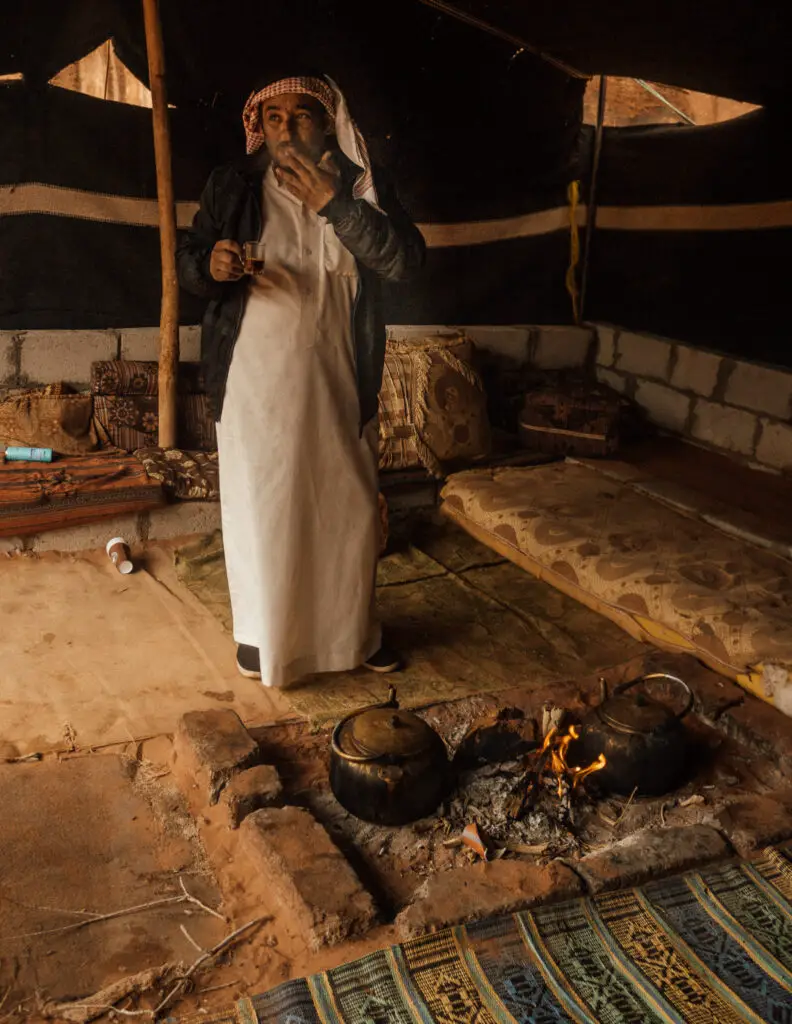
Although I found Jordan to be pretty open and easy-going comparatively to other countries in the region, I still think being mindful and over-respectful is better than potentially being culturally insensitive.
If you’ve been to a muslim country, you may already know what types of customs to adhere to. If not here are important things to remember:
What to Wear
Generally, it would be best to keep shoulders, knees and chest covered. If you want to visit a mosque, you’ll need a scarf to cover your head, although the mosque can lend you one for a fee.
Friday is Prayer Day
On Friday, if you try to go eat at a restaurant or get any errand done before noon, you will have a hard time. This is the weekly time for prayers, and most businesses will be closed as the owners head to their local mosques to pray.
Avoid Talking About Israel / Palestine
From the minute I left the airport, my host wanted to talk about Israel/ Palestine. This was not the only time, and it came up many times throughout my month in Jordan.
No matter your stance on the matter, it’s best to just listen, and not give too much of your opinion. You may underestimate just how sensitive this topic is.
I once offended my host’s friend by merely saying I was planning a trip to Israel. Seriously, tread lightly on this topic.
Itinerary for 1 Week in Jordan
Day 1: Amman
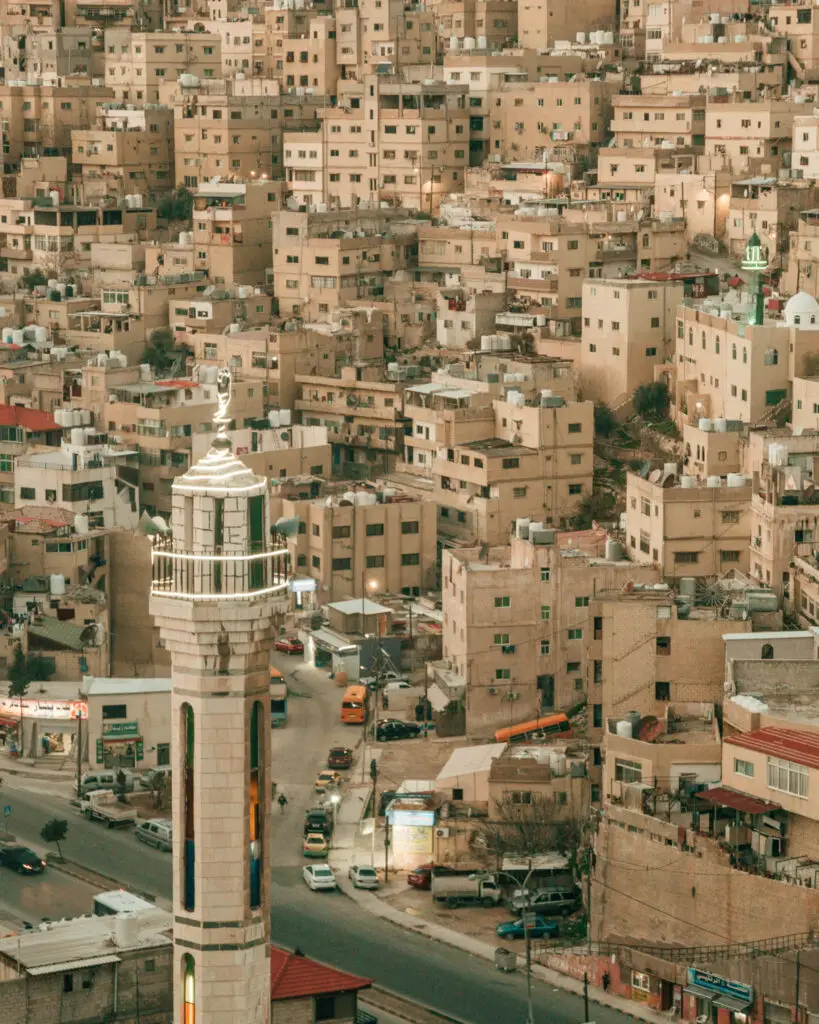
Spend your first day exploring Amman. There aren’t that many major things to see in Amman, so a full day is more than enough to see it all. Here are things to do:
King Hussein Bin Talal Mosque
This is the largest mosque in Amman, and open to tourists for visits. Please note that it is actually 10 kilometers outside the city center, on the outskirts of Amman.
It’s a large and lavishly decorated mosque. If you are willing to make the trip, it’s worth the visit.
Roman Amphitheater

If you are interested in history, this is a very well preserved insight into a past Amman, back when it was called Philadelphia, which translates to “City of Brotherly Love”.
This particular ancient amphitheater used to seat over six thousand spectators during the peak of the Roman Empire.
It’s worth noting, if you’ve seen your fair share of ancient amphitheaters before, or have already paid a visit to the Colosseum in Rome, this may be underwhelming. Feel free to skip it.
Entrance fee: 1 dinar (free with the Jordan Pass)
Eat the Best Falafel at Hashem Restaurant
This restaurant was recommended by basically everyone I met, and it did not disappoint. In a country like Jordan where eating out can be a pricey affair, this place is the perfect for budget and taste.
You can come here to get authentic, and hefty portions of falafel at local prices. Don’t forget the hummus!
A very filling meal here can cost as low as 1-2 dinars ($3.00 USD).
Find it here.
Go to the Citadel

This will be the highlight of your day in Amman, for sure. Situated high above the city on the Jebel Al Qala’a Hill, the citadel also doubles up as the best viewing point of the entire city.
I would definitely recommend going an hour or so before the closing time, or as close to sunset as possible.
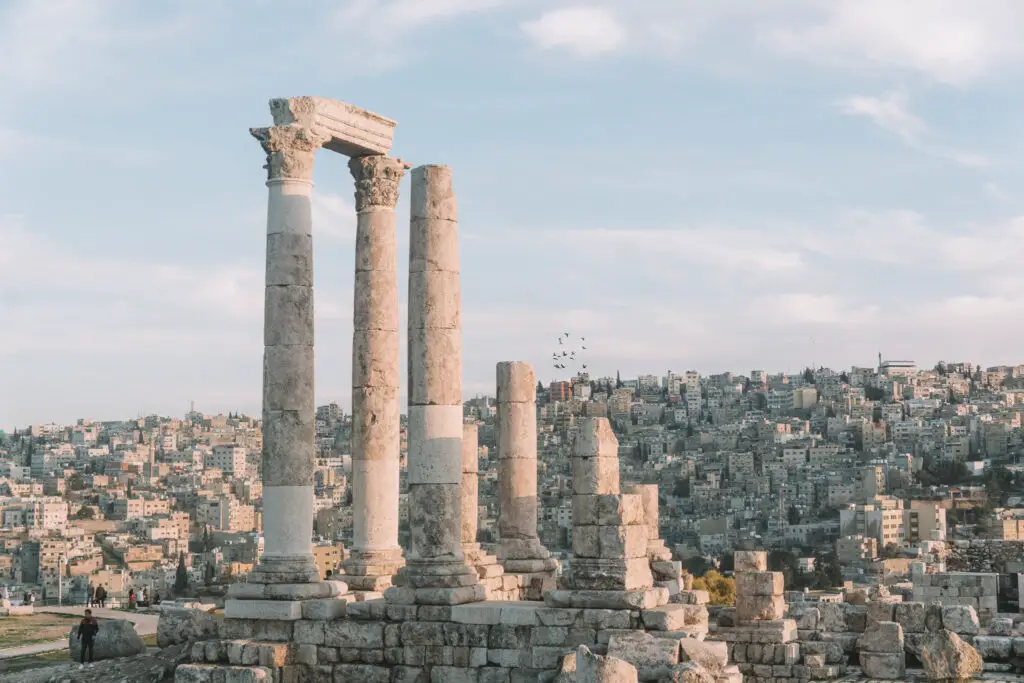

Once here, you’ll find ancient ruins from the Ammonite civilization. There are temple ruins, the most notable one being the Temple of Hercules. Its two pillared columns are the tallest structure still standing on the Citadel, and is also the best place to take sunset photos.
Entrance fee: 2 dinar ($2.82 USD) or free with the Jordan Pass
Explore Rainbow Street
If you want to experience a night out while in Jordan, look no further. This street is full of cafes, shisha bars, restaurants, and at night, people.
You can also dine at Sufra, which claims to be one of the best restaurants in all of Jordan. It is quite popular, even among Jordanian royalty, so give it a try. Here you can try some Jordanian cuisine. I recommend the mansaf.
Eat at Shawarma Saj
My local friend took me here late night, after a night of drinking on Rainbow Street. It’s crowded, and you’ll see why. It’s so freakin good, you will consider getting two.
I recommend getting a classic chicken shawarma with fries. And sauce! The dipping sauce is amazing.
Find Shawarma Saj here.
Day 2: Wadi Mujib and Dead Sea
Wadi Mujib
On day two you can head to Wadi Mujib early in the morning to go for a hike.
By car, it is about 1.5 hours from Amman.
Unfortunately, this is one of the only places you will have difficulties reaching without a car. If you are solo and don’t want to rent a car, you can always hitchike.
Jordan is an extremely safe country, so you can hitchhike without worries. As a courtesy, you can give people that pick you up 1 dinar but it’s not obligatory.
If you choose to visit Wadi Mujib, you should expect a 2 – 3 hour roundtrip hike.
This hike follows a river canyon, between towering red rock walls. It’s mostly flat, but you will be walking through the river itself, which depending on the season can be quite high. This is where your hiking boots come in handy.
Parking is free, but you can’t enter the reserve area at all without booking a guided tour. This will need to be booked in advanced.
The 3 hour trek starts at 21 dinars ($30 USD) while the full length trek is 46 dinars ($64 USD) and takes 7 hours to complete.
In the winter months, the trails are closed to the public due to higher chances of flash floods. If you want to trek Wadi Mujib, plan to visit Jordan between April and October.
If you don’t want to hike, spend the day at the sea instead.
The Dead Sea
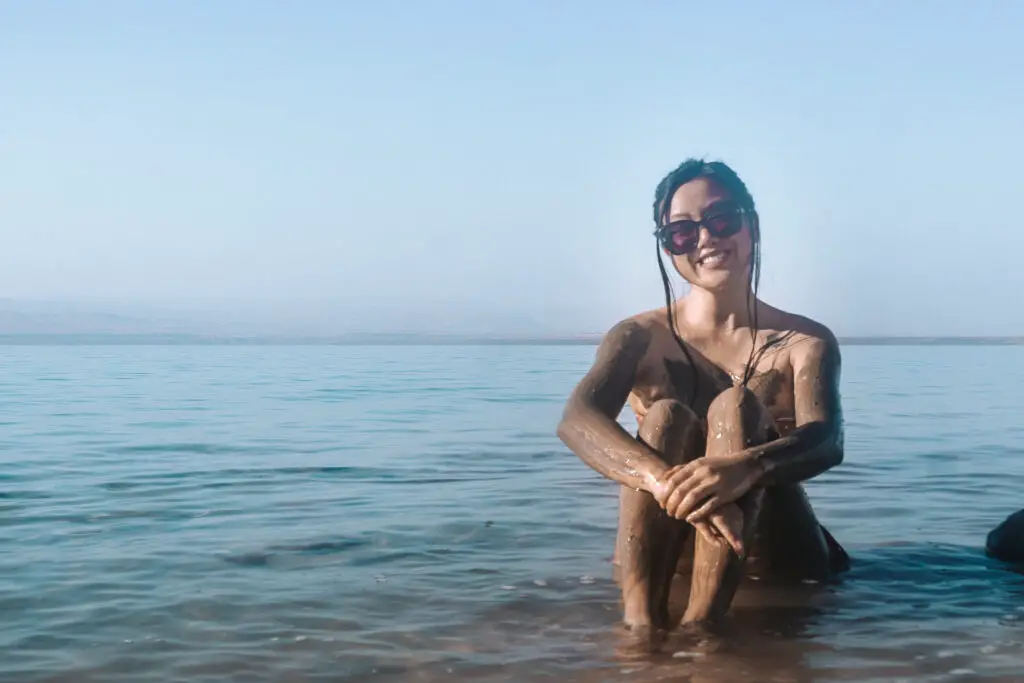
You can reach the Dead Sea by car or by public bus, from Amman.
It was a little confusing figuring out how to take the public bus, and you’ll have to be prepared for delays, but otherwise it was a smooth journey.
Note that the bus won’t take you directly to the Dead Sea, but close enough and from there you can hitchike or take a taxi. More info on how to get from Amman to the Dead Sea by bus here.
If you are driving, you’ll want to put “Amman Beach” into your GPS.
Once you arrive at the Dead Sea, you will have to pay 25 dinars ($35 USD) to enter the beach areas.
Tourist Beach vs Local Beach
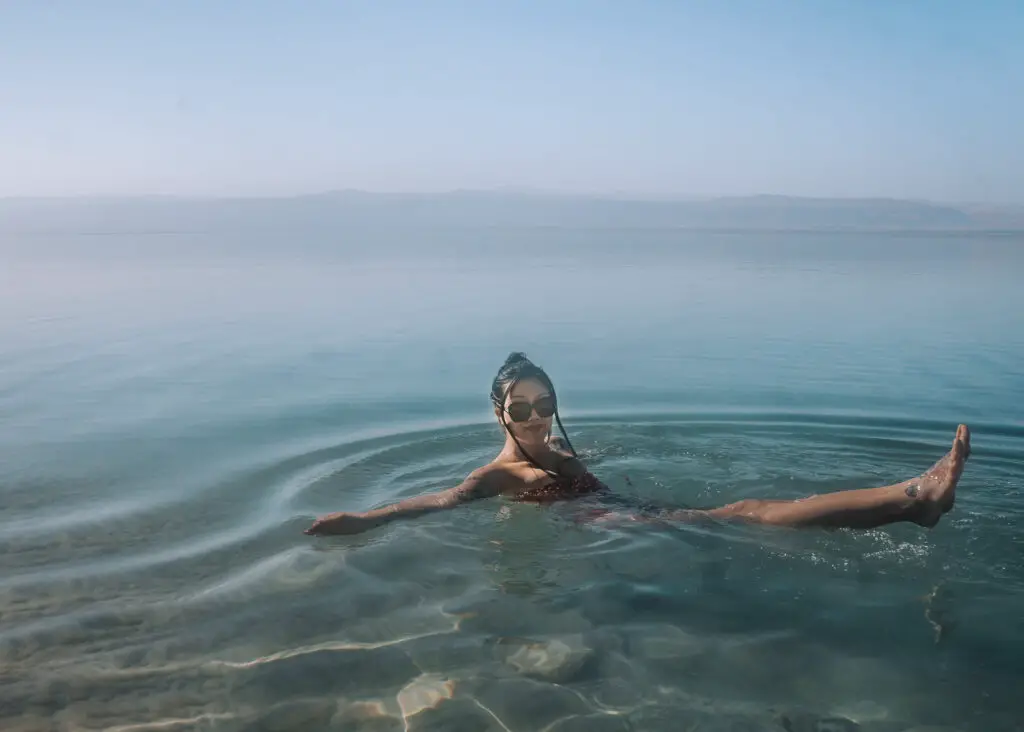
Once inside, you will realize there is a designated tourist resort area, that charges an additional fee to enter. They will tell you that this is where you can get access to the Dead Sea mud, but that isn’t true.
The Dead Sea mud can be found on the local side of the beach too. The only difference is that on the tourist beach, they have already dug it up and it’s easily accessible.
The positive to entering the tourist beach is that you’ll be free to swim in a bikini. However, if you are ok with swimming with a t-shirt on, and shorts for the ladies, the local beach is exactly the same.
I chose to swim at the local beach, and it was awesome. I even made some Jordanian friends, who drove me back to Amman later in the evening. It is a bit uncomfortable swimming in a shirt, but whatever.
You can spend the afternoon here slapping Dead Sea mud on your skin or floating in the dense, salty water. Whatever you do, just don’t put your face in the water.
The salt content is more than enough to burn your eyes and cause permanent damage. Avoid getting any of the water near your face to be safe.
Stay for sunset to top off an amazing day.
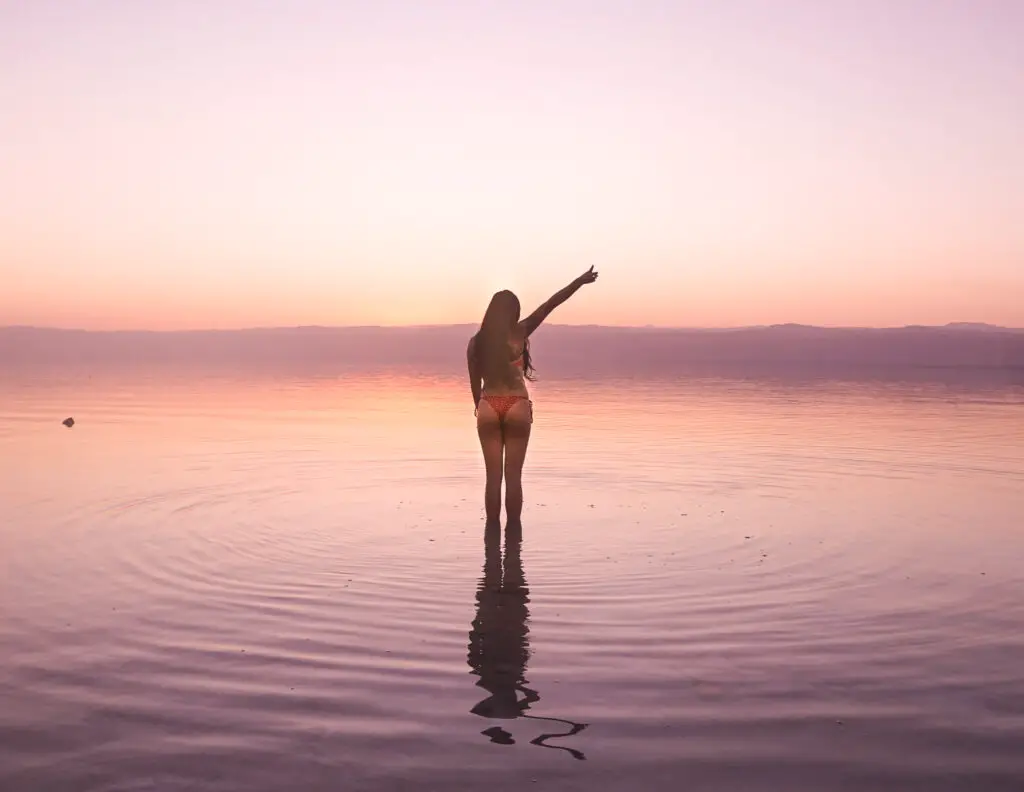
If you have a car and the budget, you can opt to stay at one of the resorts or hotels nearby.
If you don’t have a car or don’t want to stay at a resort, you should head back to Amman for the night.
Day 3: Drive to Petra

Petra will likely be the highlight of your 1 week in Jordan, no doubt. Getting to Petra by bus or car, should take a few hours in the morning.
By Bus
You’ll need to get to the bus terminal early in the morning. The bus leaves around 7:00 AM, and is more or less on schedule. You will arrive in Petra after 3 hours.
Check the website for updated timetables here.
Arriving at Petra
If you have the Jordan Pass, it will be free, but you may want to purchase a ticket for the Petra by Night experience.
Is Petra by Night Worth it?

The show is only on Monday, Wednesday and Thursday, so if you want to go plan your visit accordingly.
It involves watching a show of singing and music, while sitting on the floor in front of the Treasury.
Honestly, it seemed somewhat a tourist trap. But, is it a beautiful way to see the Treasury at night. If you have a tripod and are a photographer, you could get amazing photos of the candles and The Treasury here.
Price: 17 dinars (not included in the Jordan Pass)
Al Siq
A photogenic passageway through a canyon, that leads you from the entrance of Petra, to The Treasury. You will pass through it every time you enter and exit Petra.
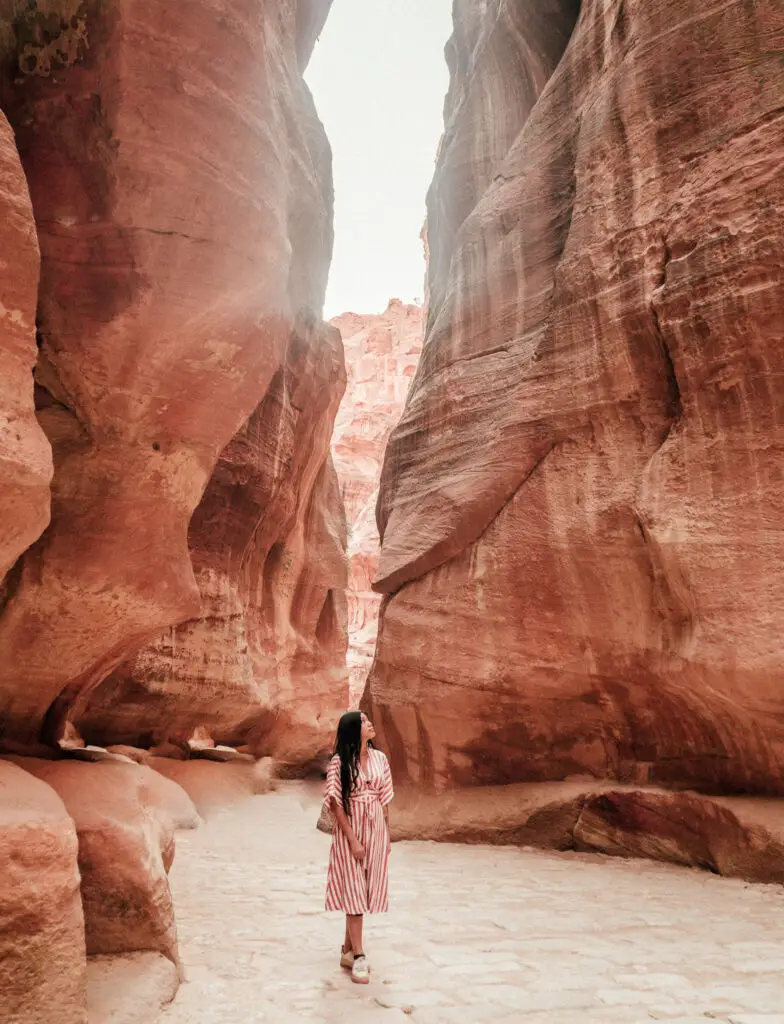
Hike to the Tea Shop

For the first half day, I’d recommend doing a hike up to the viewing point of the Treasury. It’s an easy to moderate hike (I did it in a dress), and you will be rewarded by the cutest tea shop at the top!!
It’s a simple, Bedouin tent, run by a family. They offer teas, juices and a place to charge your electronics. It has the BEST view of the Treasury and you can take a nap with a bunch of cats.
This is also a popular photo spot. Wait until the second half of the afternoon for the best lighting, without any harsh shadows for the best photo.
Petra by Night
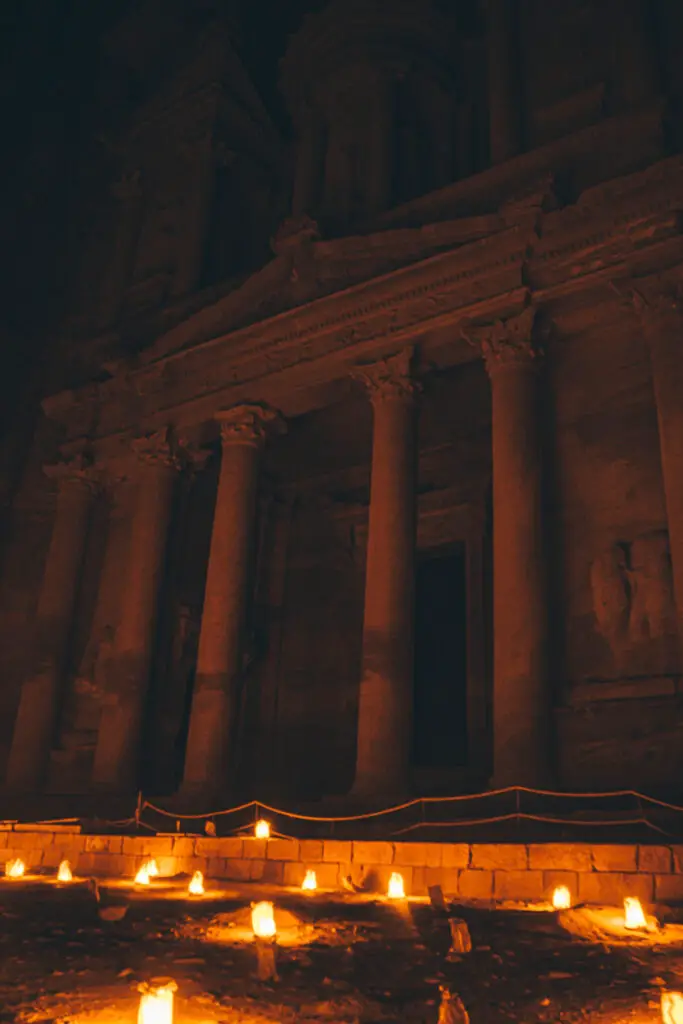
Depending which day you go, you may either do this on the first or second night of your stay in Petra, since they only have it 3 times a week.
Remember to come early, if you want a good photo. I would say even plan to be at the entrance walking to the Treasury 1 hour before it starts.
The walk takes 30 minutes, and you’ll want to get there before the crowds. You’ll need a tripod for best results. Also, bring a flashlight for the walk.
Day 4: Full Day in Petra
Morning at The Treasury
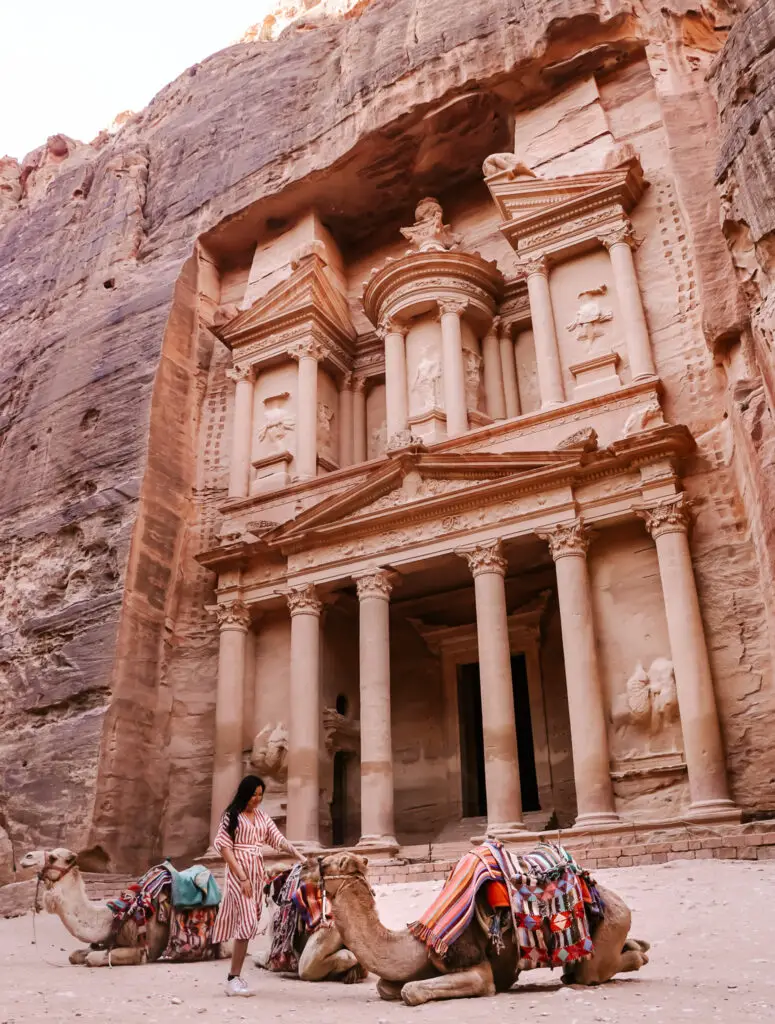
Entry into Petra begins from 6:00 AM, so you’ll want to wake up very early on this day. You want to beat the crowds and go straight to the Treasury for sunrise. This is when you will have it to yourself for the best photos.
Even if you don’t care about photography, you honestly need to see it in the stillness of morning to fully enjoy it. You’ll have it almost to yourself, minus other photographers and camels.
Hike to The Monastery
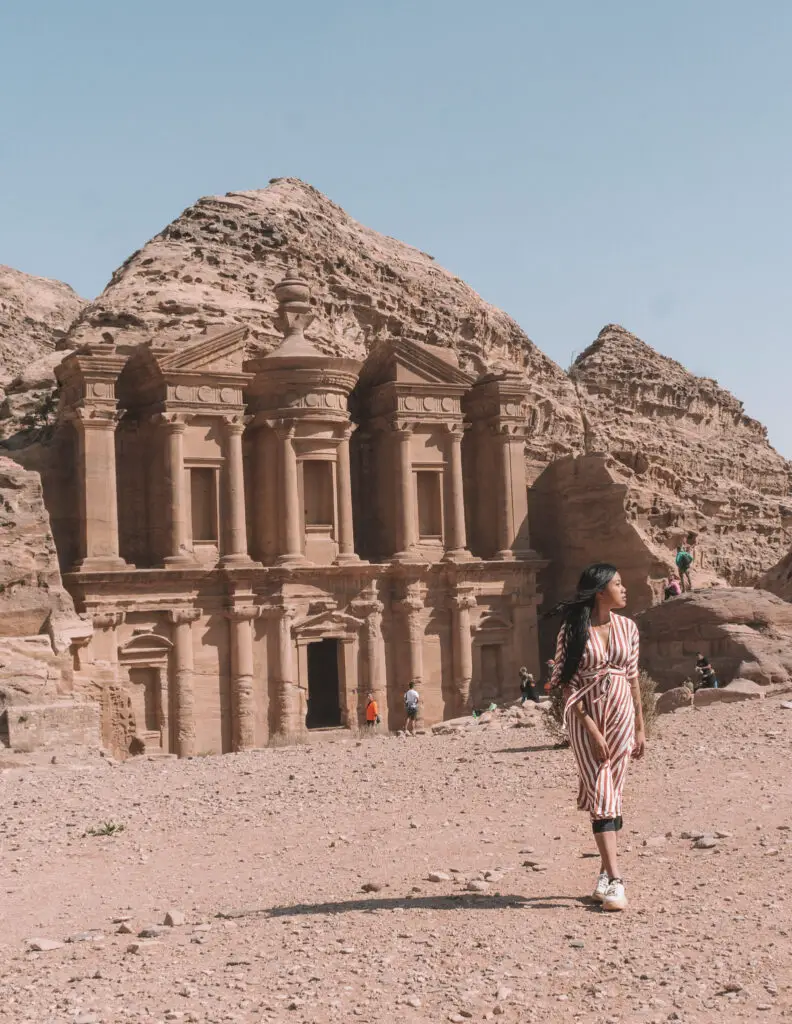
This is a 6 km (3.6 mile) roundtrip walk from The Treasury, and involves a steep climb up roughly 850 steps at the end. Which is why you’ll want to start the day early!
I found the hike to be very easy, and by starting early you can avoid the hottest part of the day for the ascent. The Monastery is definitely worth the short trek, and if you need to take breaks on the way, there are lots of gift shops and tea shops.
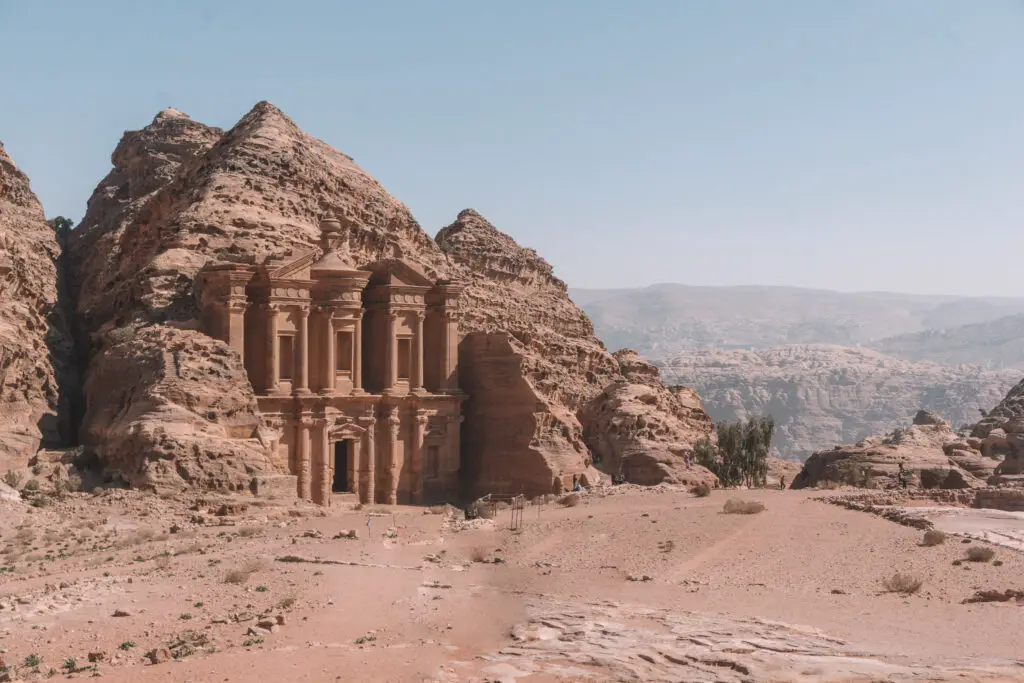
Once you arrive, you can spend an hour or so in this area exploring caves, view the “End of the World” or have a coffee break. On your way back, you can stop by all the other attractions along the trail.

The ones I think are worth seeing (in order from the hike back from The Monastery to The Treasury) are
- The Great Temple
2. The Royal Tombs
3. The Palace Tomb
4. The Urn Tomb
5. Nabatean Theatre
6. Renaissance Tomb

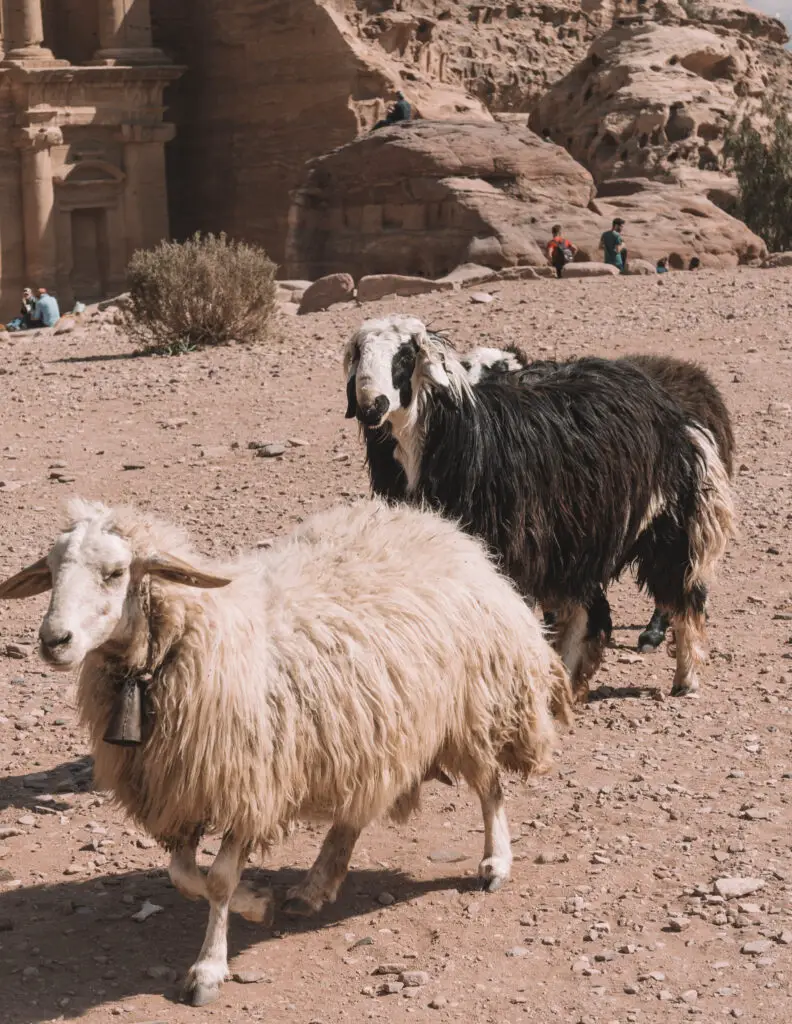
Day 5: Head to Wadi Rum
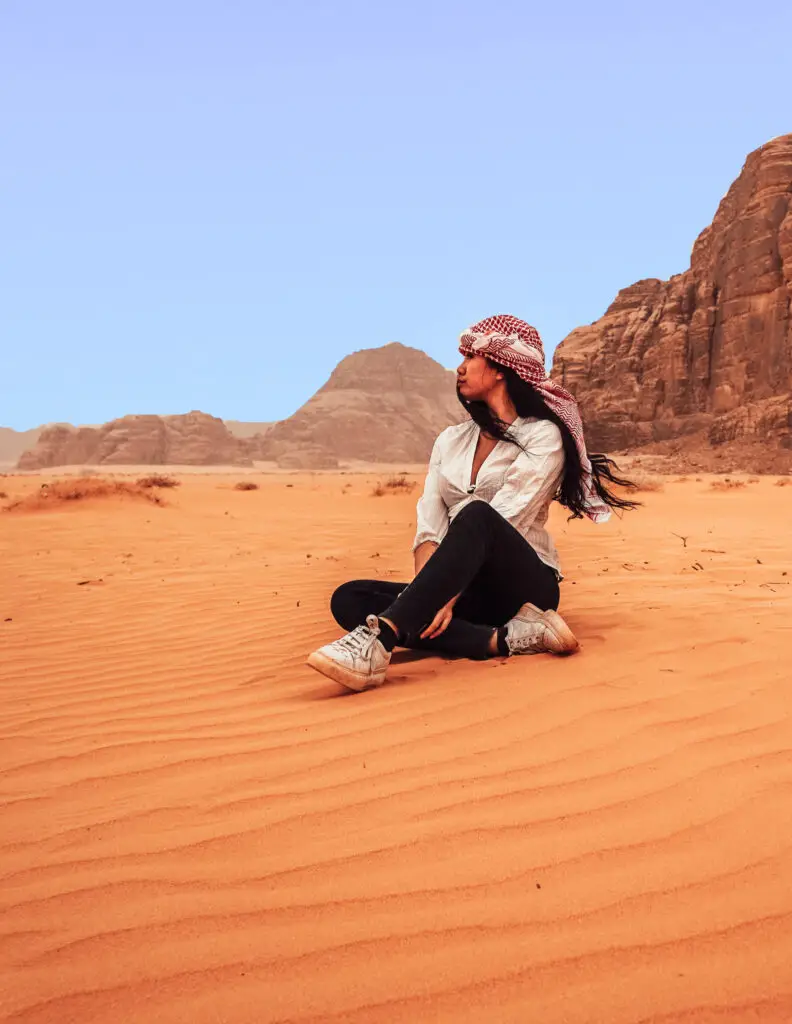
You can drive to Wadi Rum, or take a public bus which departs around 6:30 AM from Petra.
For the bus, check with your hotel, and make sure they book your seat for you at least a day before departure. It takes about 2 hours.
For your stay in Wadi Rum, you’ll want to camp in the desert overnight. There are several campsites to choose from, most of which will provide your sleeping arrangement, meals and help arrange your excursions into the desert.
I stayed at Wadi Rum Bedouin Camp, and can recommend them. They provided us with shisha and really good food every night and morning. The wifi was also really strong.

The Wadi Rum desert is an amazing place, where you don’t need to be doing something to enjoy it. I spent my first afternoon hiking and exploring the canyons and dunes near my camp.
Day 6: Full Day in Wadi Rum
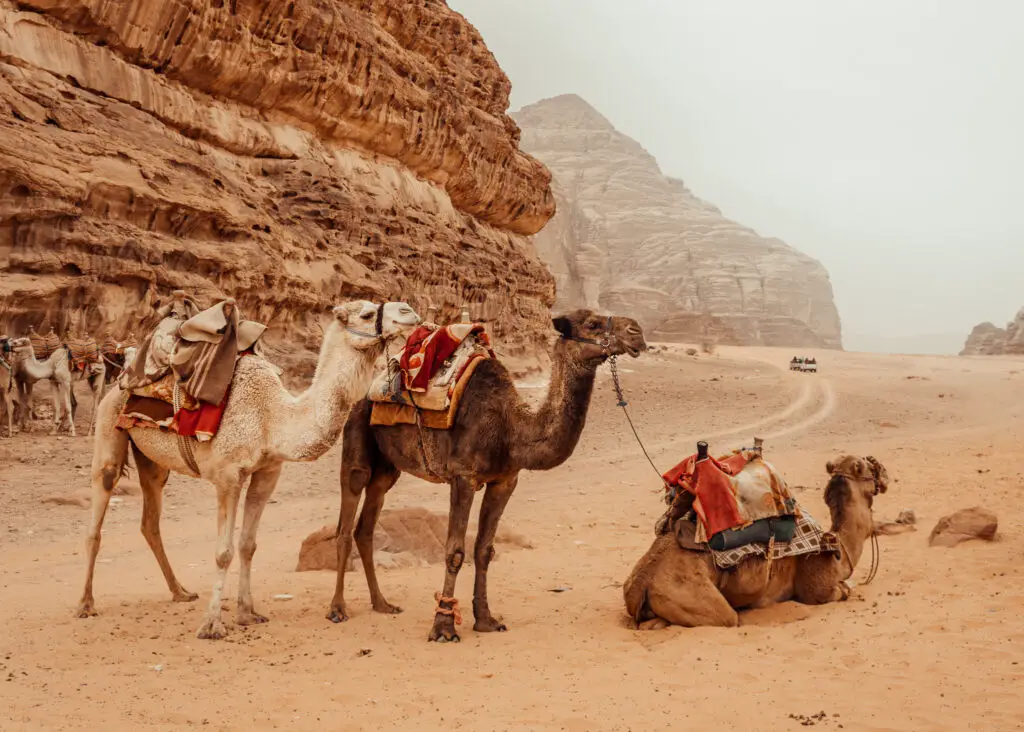
You need at least one full day to explore the Wadi Rum desert. You can discuss with your accommodation what you’d like to see and they can organize everything for you. Things I recommend seeing and doing are:
Go on a Jeep Tour
This will be necessary to explore the far corners of the desert. Depending on what you want to see, this could take one hour or several.
Burdah Rock Bridge
You can reach this rock bridge on a Jeep Tour. You can climb up it, if you’re not afraid of heights. Bring proper shoes, the rock on the way up is.a bit slippery.
Alameleh Inscriptions
The historical significance of Wadi Rum can be understood by finding the many ancient inscriptions still found in the rock throughout the desert. They are hard to spot on your own, but your guide can definitely direct you to some.
Go for a Camel Ride

Riding a camel is a popular way to get around the desert, although a slow and bumpy one. Personally, I don’t like riding animals and prefer to admire them from the ground.
Desert Hike

You can opt to explore the desert on foot in some areas. There are canyons between deep red rock formations to walk through, or you can go up a sand dune to get better views of the desert from above.
This should probably be done with a group or guide, to avoid getting lost.
Watch the Sunset
There is nothing in the world like those Arabian desert sunsets. Be sure to stop whatever you’re doing to get to a viewing point, to catch the sunset every evening while in Wadi Rum. Never miss a sunset here!
Day 7: Head Back to Amman
On your last day in Jordan, head back to Amman by car or bus.
By Bus
You will have to take a bus from Wadi Rum to Petra, and catch the afternoon JETT bus back to Amman. You can ask your campsite staff to help you book your seat on the bus.
By Car
If you have a car, you can make a few last minute stops on the way back. One place that I didn’t visit, but was recommended, was Mount Nebo.
If you Have More Than 1 Week in Jordan
Head to Aqaba in the very south of Jordan and spend the rest of your trip relaxing by the Red Sea.
Here you can snorkel, sun bath and even get scuba diving certification.
How to Save Money

Jordan is not exactly a budget destination. The Jordanian dinar currently ranks as the 4th highest in value in the world.
However, that’s not to say it’s a trip that has to break the bank. Here are ways to save money during your 1 week in Jordan.
Use the Jordan Pass
This is likely the most important tip for saving money. No matter the length of your trip, this pass will save you a ton.
It pays for itself instantly by including your entry fee into the country and entry into Petra. Everything else you use it on, will be money saved.
Take the Bus
If you are a solo traveler, it may not be cost effective to rent a car for yourself. Even with only 1 week in Jordan, you can see the country by bus, even if it’s a bit slower.
Beside Wadi Mujib and Mount Nebo, everything included in this itinerary can be visited without a car or tour.
For getting from Amman to Petra, there is the JETT Tourist Bus.
From Petra to Wadi Rum, there is a public bus that runs once a day. Check with your accommodation to book a seat on the bus in advanced.
The bus from Petra to Wadi Rum usually leaves at 7 AM, but you should check with your hotel for current timetables.
The buses are clean, very safe, and you will be riding with mostly other tourists.
It’s worth noting, that hitchhiking, in Jordan is also very safe and easy. However, if you only have 1 week in Jordan, I would feel uneasy recommending that you succumb your limited time to the unpredictable timetable you’d create for yourself, by relying on hitchhiking.
Use Uber instead of Taxi
In Amman, I took a taxi once. Of course, it was the only time I was scammed and ripped off.
In short, just use Uber. The price is designated by the app, and it’s just the most hassle free way to get around the city.
Eat Falafel
The cost of food in Jordan can quickly add up. I couldn’t find a place open on a Friday, during prayer time, so I stopped by the Hyatt. It ended up being $46 for an appetizer platter.
The cheapest food in Jordan, is definitely falafel closely followed by shawarma.
Avoid Alcohol
Alcohol comes at a premium price here. Go easy on the beers, to avoid overpaying. If you are only spending 1 week in Jordan, I think you can live without it altogether.
Swim at the Local Beaches
Unless you really can’t stand the idea of swimming with clothes on, the local beach is the better option all around. Why travel to be enclosed in a tourist bubble AND pay an arm and leg for it?
Safety in Jordan
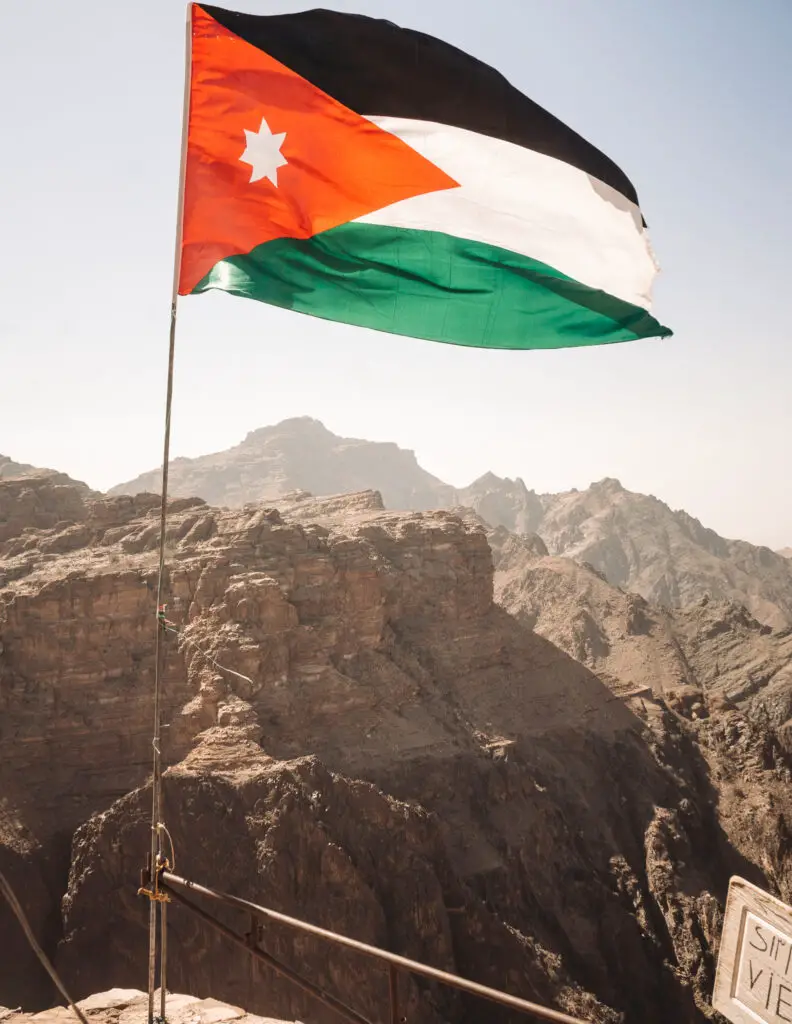
I spent far more than 1 week in Jordan, and rarely encountered any major unsafe situations.
As a solo female traveler, I can confidently report back that Jordan was by far one of the safest countries I’ve been to. There was police presence everywhere, and everything seemed very orderly.
As for Jordanian people, they are very friendly, but also tend to keep more to themselves, except in Amman. In Amman, I found people to be really open and easy to become friends with.
The only time I felt a little on edge, was in Petra, with the many buskers trying to offer or sell you things.
And that wraps up my guide on how to spend 1 week in Jordan, for solo female travelers. Have you been to Jordan? What did you love or hate?
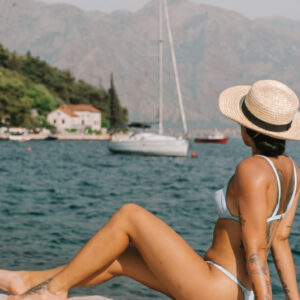 Why Long Term Travel Turns You Into a Weirdo
Why Long Term Travel Turns You Into a Weirdo Can I go to Egypt as a Solo Female Traveler?
Can I go to Egypt as a Solo Female Traveler? Worst Things that Happened to Me While Traveling
Worst Things that Happened to Me While Traveling What it’s Like to Live in Paris as an American Girl
What it’s Like to Live in Paris as an American Girl


Great tips and itinerary to Jordan. So much interesting information. I would love to see Petra at night and swim in the Black Sea.
You can’t miss Petra, for sure!
Thank you so much for this article, I’ve resisted booking this for a while now as I wasn’t sure it would be ok as a solo trip. Appreciate the tips, its so easy to forget how sensitive matters are in other countries. A friend of mine upset one of her hosts in Israel by getting into a discussions the political issues. Your pictures are gorgeous btw
Oh wow, yes, it’s such a sensitive topic best to avoid it when possible. But otherwise it’s a totally safe country to travel solo I hope you will get to visit it soon!
Thank you for a guide full of helpful tips. I have been looking at a trip here for some time and this was one of the best guides I have come across for practical pointers. Thank you
You are welcome! I hope you have a great time in Jordan.
This website, you can find a wide selection of slot machines from top providers.
Visitors can experience traditional machines as well as modern video slots with vivid animation and exciting features.
If you’re just starting out or a seasoned gamer, there’s always a slot to match your mood.
slot casino
The games are ready to play round the clock and optimized for PCs and mobile devices alike.
You don’t need to install anything, so you can jump into the action right away.
Platform layout is easy to use, making it convenient to explore new games.
Join the fun, and discover the excitement of spinning reels!
This section showcases CD/radio/clock combos crafted by trusted manufacturers.
You can find sleek CD units with FM/AM reception and dual wake options.
Most units feature AUX jacks, device charging, and memory backup.
Our range spans value picks to high-end designs.
best home radio cd player
All clocks provide snooze buttons, auto-off timers, and bright LED displays.
Buy now are available via online retailers with fast shipping.
Find your ultimate wake-up solution for bedroom or office use.
On this platform, you can access a great variety of online slots from leading developers.
Visitors can experience retro-style games as well as feature-packed games with vivid animation and bonus rounds.
Whether you’re a beginner or a seasoned gamer, there’s a game that fits your style.
casino games
The games are instantly accessible round the clock and compatible with PCs and tablets alike.
No download is required, so you can start playing instantly.
Platform layout is user-friendly, making it simple to explore new games.
Sign up today, and dive into the thrill of casino games!
Приобретение медицинской страховки при выезде за границу — это важный шаг для спокойствия туриста.
Сертификат обеспечивает неотложную помощь в случае несчастного случая за границей.
К тому же, сертификат может охватывать покрытие расходов на медицинскую эвакуацию.
страховка за границу
Многие страны обязывают предоставление документа для въезда.
Без наличия документа медицинские расходы могут быть финансово обременительными.
Покупка страховки заранее
¡Hola aficionados a las apuestas !
La mejor forma de probar tragamonedas sin pagar es con un bono sin depГіsito. 25 giros gratis te esperan hoy mismo. Sin condiciones ocultas.
Miles de jugadores ya estГЎn aprovechando 25 giros gratis sin depГіsito para ganar sin poner ni un euro.
¡Que tengas magníficas tiradas de suerte !
¡Hola, fanáticos de los juegos de azar !
Esta oferta te permitirГЎ conocer la interfaz de los casinos sin arriesgar tu dinero.
Conseguir 10 euros gratis por registrarte es mГЎs fГЎcil que nunca. Simplemente crea una cuenta y comienza a jugar sin invertir tu propio dinero. Es la oportunidad perfecta para nuevos jugadores en EspaГ±a.
Casinos con bonos de 10€ gratis sin ingreso – п»їhttps://www.youtube.com/watch?v=DvFWSMyjao4
¡Que tengas excelentes beneficios !
Searching for someone to handle a rare dangerous job?
This platform specializes in connecting customers with freelancers who are willing to tackle critical jobs.
If you’re handling emergency repairs, unsafe cleanups, or complex installations, you’ve come to the right place.
Every available professional is pre-screened and certified to ensure your security.
rent a hitman
This service offer clear pricing, comprehensive profiles, and safe payment methods.
No matter how challenging the situation, our network has the expertise to get it done.
Start your quest today and find the ideal candidate for your needs.
Here, find an extensive collection 18+ content.
Every video is carefully curated guaranteeing maximum satisfaction to viewers.
Searching for particular categories or casually exploring, this resource has something tailored to preferences.
teen photo
New videos uploaded frequently, to keep the library current.
Access to the full range protected for individuals over 18, maintaining standards and safety measures.
Keep updated for new releases, because the resource adds more content daily.
¡Hola exploradores de la suerte !
Casinosinkyc.guru es accesible desde cualquier dispositivo. No necesitas apps ni descargas. Solo abre el navegador y juega.
ВїQuieres empezar a jugar ya? Con casinos sin registro, no hay esperas ni formularios. [url=http://casinosinkyc.guru/]casino sin registro[/url]Solo seleccionas tu juego y listo.
casino sin registro ideal para jugar rГЎpido – п»їhttps://casinosinkyc.guru/
¡Que tengas maravillosas botes fabulosos!
¡Saludos, aficionados a las apuestas!
Los casinos online dinero real chile te ofrecen la oportunidad de jugar y ganar desde la comodidad de tu hogar[url=п»їhttps://www.youtube.com/watch?v=CRuk1wy6nA0]Casinos virtual[/url]Con opciones seguras y licencias vГЎlidas, puedes confiar en tus apuestasAdemГЎs, hay juegos para todos los gustos.
Casinos online sin depГіsito Chile para jugar sin invertir – https://www.youtube.com/watch?v=CRuk1wy6nA0&list=PLX0Xt4gdc3aJG7y03Wh5Qf0JrapCEgMFH
Jugar sin depГіsito chile es una alternativa excelente para quienes desean probar suerte sin arriesgar su dinero. Con solo registrarte, puedes acceder a bonos y juegos seleccionados. Es la forma perfecta de explorar un nuevo casino.
¡Que disfrutes de grandes logros !
Свадебные и вечерние платья нынешнего года отличаются разнообразием.
Популярны пышные модели до колен из полупрозрачных тканей.
Блестящие ткани создают эффект жидкого металла.
Асимметричные силуэты становятся хитами сезона.
Разрезы на юбках придают пикантности образу.
Ищите вдохновение в новых коллекциях — оригинальность и комфорт сделают ваш образ идеальным!
http://vzinstitut.cz/index.php/forum/ideal-forum/7220-i-am-very-happy-to-cme-here?start=60#379603
Свадебные и вечерние платья нынешнего года отличаются разнообразием.
Популярны пышные модели до колен из полупрозрачных тканей.
Металлические оттенки делают платье запоминающимся.
Асимметричные силуэты становятся хитами сезона.
Минималистичные силуэты подчеркивают элегантность.
Ищите вдохновение в новых коллекциях — оригинальность и комфорт превратят вас в звезду вечера!
https://nonghuachang-sao.go.th/forum/suggestion-box/405424-r-nd-vi-sv-d-bni-f-s-ni-s-ic-s-s-v-i-p-vib-ru
¡Hola, jugadores expertos !
Encontrar casinosonlineconbonodebienvenida confiables es clave para tener una buena experiencia. Estos sitios deben tener licencia y condiciones claras. [url=п»їhttps://casinosonlineconbonodebienvenida.xyz/]casinos con bono de bienvenida[/url]Revisa siempre los tГ©rminos del bono.
Consigue tu slots bono de bienvenida sin depГіsito – https://casinosonlineconbonodebienvenida.xyz
Muchos bonos casino EspaГ±a estГЎn disponibles solo para residentes. Verifica tu elegibilidad antes de registrarte. AsГ evitas problemas con los retiros.
¡Que disfrutes de galardones únicos !
Свадебные и вечерние платья 2025 года отличаются разнообразием.
В тренде стразы и пайетки из полупрозрачных тканей.
Металлические оттенки создают эффект жидкого металла.
Асимметричные силуэты определяют современные тренды.
Минималистичные силуэты создают баланс между строгостью и игрой.
Ищите вдохновение в новых коллекциях — стиль и качество оставят в памяти гостей!
http://forum.gokickoff.com/index.php?topic=262429.new#new
The Audemars Piguet Royal Oak 16202ST features a elegant stainless steel 39mm case with an ultra-thin profile of just 8.1mm thickness, housing the advanced Calibre 7121 movement. Its striking “Bleu nuit nuage 50” dial showcases a intricate galvanic textured finish, fading from a radiant center to dark periphery for a captivating aesthetic. The octagonal bezel with hexagonal screws pays homage to the original 1972 design, while the glareproofed sapphire crystal ensures optimal legibility.
http://provenexpert.com/en-us/ivanivashev/
Water-resistant to 50 meters, this “Jumbo” model balances sporty durability with luxurious refinement, paired with a stainless steel bracelet and reliable folding buckle. A modern tribute to horological heritage, the 16202ST embodies Audemars Piguet’s innovation through its meticulous mechanics and timeless Royal Oak DNA.
clomid pills for sale generic clomiphene price order generic clomiphene online where to buy cheap clomid tablets how to get cheap clomid without dr prescription where to buy generic clomiphene no prescription how can i get cheap clomiphene without prescription
¡Hola, seguidores del casino !
El control de tus fondos es mГЎs flexible al no estar sujetos a normativas espaГ±olas. casinofueradeespana.xyz Puedes mover el dinero a tu ritmo.
Casinos online fuera de espaГ±a con bonos sin depГіsito – п»їhttps://casinofueradeespana.xyz/
Jugar en casinos fuera de EspaГ±a es ideal si buscas mantener el control total de tus datos personales. Puedes usar emails temporales o mГ©todos de pago alternativos. AsГ tu privacidad estГЎ garantizada.
¡Que disfrutes de oportunidades exclusivas !
viagra pharmacy: order viagra online pharmacy – first medicine online pharmacy store discount code
¡Bienvenidos, entusiastas del casino !
Muchos jugadores eligen estas plataformas por la ausencia de lГmites autoimpuestos. Puedes jugar cuanto desees sin intervenciГіn externa. Para comenzar a explorar, visita casinoonlinefueradeespana.xyz y empieza hoy.
Casino por fuera: consejos para aprovechar mejor los bonos – п»їhttp://casinoonlinefueradeespana.xyz/
Las retiradas en casinos fuera de espaГ±a no requieren justificaciГіn ni documentos adicionales. Todo se procesa de manera rГЎpida y directa. En casinoonlinefueradeespana tu tiempo vale.
¡Que vivas sesiones triunfales !
Looking for special 1xBet coupon codes ? This platform is your go-to resource to discover rewarding bonuses tailored for players .
If you’re just starting or a seasoned bettor , the available promotions ensures maximum benefits across all bets.
Keep an eye on daily deals to maximize your rewards.
https://gravatar.com/warmthoroughly415217d5fe
Available vouchers are regularly verified to ensure functionality this month .
Don’t miss out of limited-time opportunities to revolutionize your odds of winning with 1xBet.
На данном сайте вы найдете мессенджер-бот “Глаз Бога”, позволяющий найти данные о гражданине по публичным данным.
Бот функционирует по номеру телефона, обрабатывая актуальные базы в сети. С его помощью осуществляется 5 бесплатных проверок и детальный анализ по фото.
Сервис проверен согласно последним данным и охватывает аудио-материалы. Бот поможет проверить личность в соцсетях и предоставит результаты за секунды.
https://glazboga.net/
Это инструмент — идеальное решение в анализе персон онлайн.
Searching for special 1xBet promo codes ? Our website is your best choice to access rewarding bonuses tailored for players .
If you’re just starting or an experienced player, verified codes guarantees maximum benefits across all bets.
Stay updated on weekly promotions to maximize your betting experience .
https://1xbet-free-bet-promo-code-2.federatedjournals.com/unlock-exciting-betting-opportunities-with-1xbet-promo-codes-in-2025-1749138490
All listed codes are regularly verified to guarantee reliability in 2025 .
Don’t miss out of limited-time opportunities to enhance your betting strategy with 1xBet.
На данном сайте доступен Telegram-бот “Глаз Бога”, позволяющий собрать всю информацию о гражданине через открытые базы.
Инструмент работает по фото, используя доступные данные в Рунете. Через бота можно получить пять пробивов и глубокий сбор по запросу.
Сервис обновлен на август 2024 и включает аудио-материалы. Сервис гарантирует проверить личность в открытых базах и покажет информацию в режиме реального времени.
https://glazboga.net/
Данный сервис — помощник в анализе людей удаленно.
В этом ресурсе вы можете найти самыми свежими новостями регионов и глобального масштаба.
Материалы обновляются в режиме реального времени .
Представлены фоторепортажи с эпицентров происшествий .
Экспертные комментарии помогут получить объективную оценку.
Информация открыта бесплатно .
https://centre-beauty.ru
Searching for exclusive 1xBet promo codes? This site offers verified bonus codes like 1x_12121 for new users in 2024. Get €1500 + 150 FS as a first deposit reward.
Activate trusted promo codes during registration to boost your bonuses. Benefit from risk-free bets and exclusive deals tailored for casino games.
Find monthly updated codes for 1xBet Kazakhstan with fast withdrawals.
Every voucher is tested for accuracy.
Don’t miss limited-time offers like 1x_12121 to increase winnings.
Valid for new accounts only.
https://omsi2mod.ru/forum/12-5594-1
Experience smooth rewards with instant activation.
Access detailed information about the Audemars Piguet Royal Oak Offshore 15710ST here , including market values ranging from $34,566 to $36,200 for stainless steel models.
The 42mm timepiece boasts a robust design with automatic movement and water resistance , crafted in titanium.
Used Piguet Royal Oak Offshore Diver 15710 st prices
Analyze secondary market data , where limited editions command premiums , alongside vintage models from the 1970s.
View real-time updates on availability, specifications, and resale performance , with free market analyses for informed decisions.
Thanks on putting this up. It’s okay done.